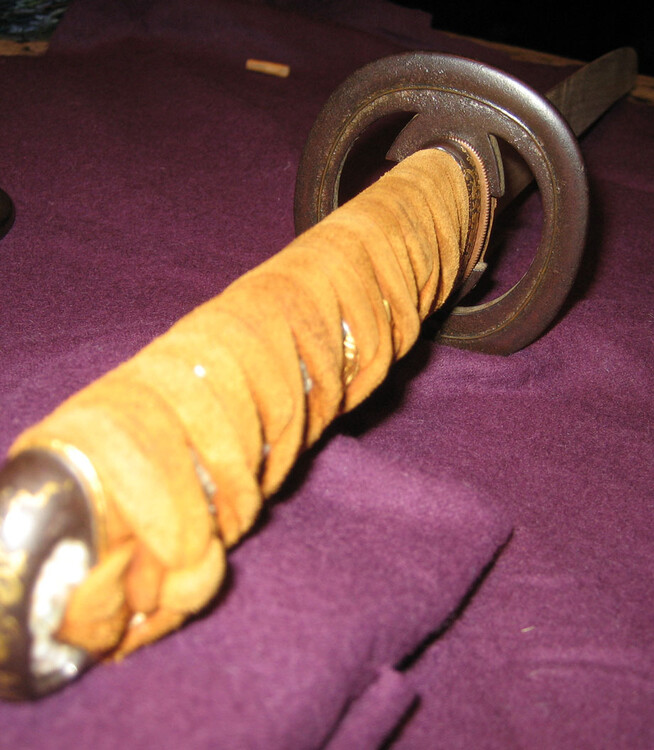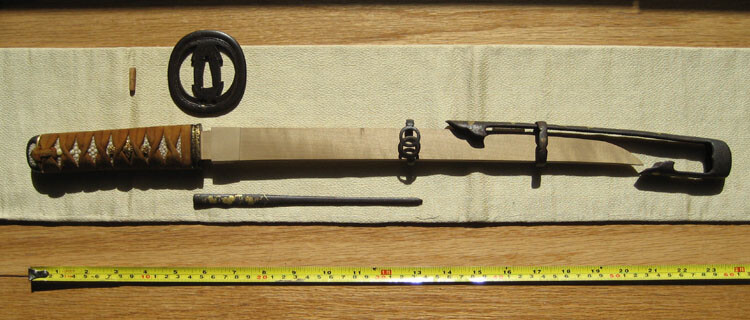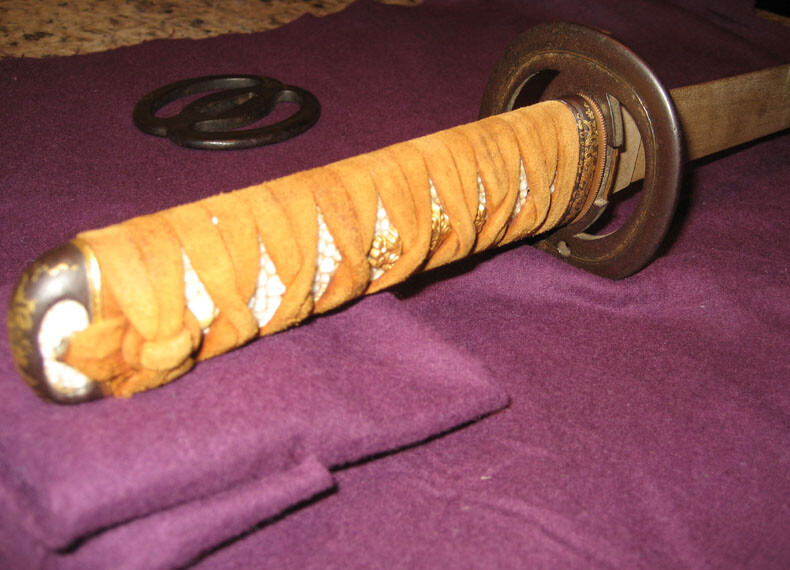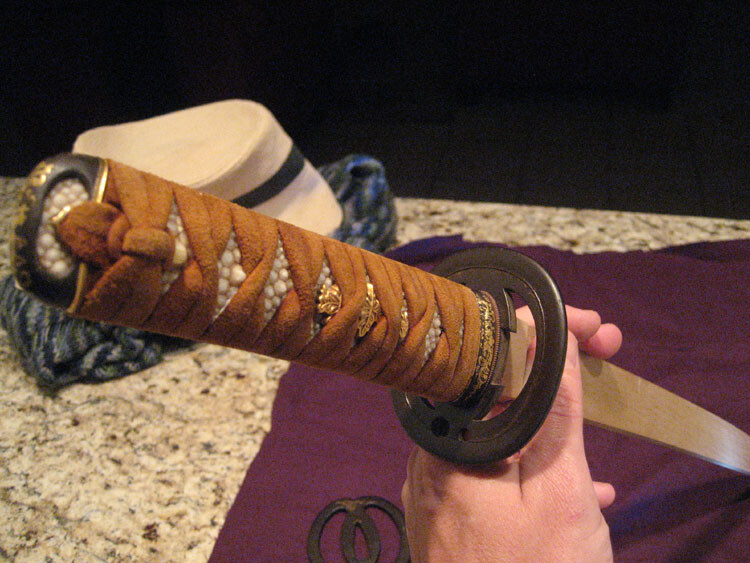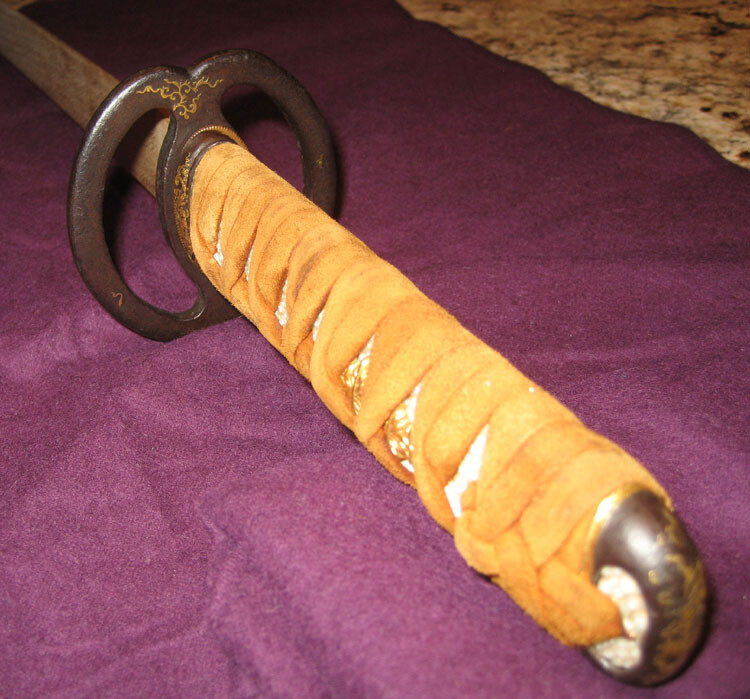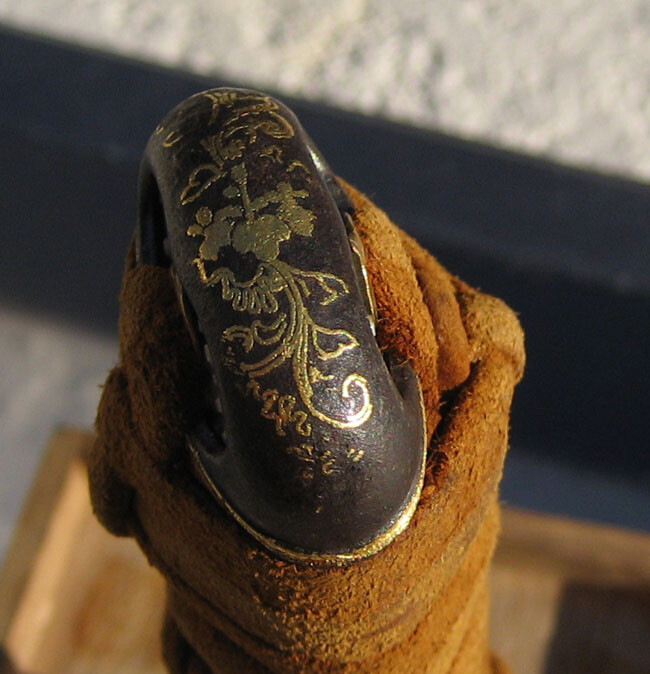-
Posts
4,427 -
Joined
-
Last visited
-
Days Won
21
Content Type
Profiles
Forums
Events
Store
Downloads
Gallery
Everything posted by Curran
-
David, I am not sure I understand exactly what is the question. There were no question marks in your post. Having seen a tsuba I strongly believed late Muromachi, but with the papers not saying 'Ko-katchushi ', I recently asked the question about NBTHK attributions of the last few years. I have seen fittings with older Hozon papers that I regarded as late muromachi, and the papers said 'ko-katchushi'. However, Rich T and possibly Peter K (?) voiced opinions which left me to infer that nowadays the 'Ko-' attribution is only on Hozon katchushi or tosho if more mid-muromachi or earlier. I don't know if this is absolutely true, but it seems to hold in my limited experience with tsuba designated as such with NBTHK papers in the past 6 or 7 years. I hope that information is accurate and helps a bit. Don't stand on it as Fact. Curran
-
The tsuba supposedly changed hands in Japan for about $800 and now is on eBay: http://www.ebay.com/itm/4482-Japanese-S ... 4ab12ac1db The seller says it reads as 'Shomin', which is how John suggested. Is anyone able to connect this to any of the tsuba smiths listed in Haynes? It may just be a strange gimei. As an aside: Shomin H 08764.0 seems to have some errors in linking to other Haynes references and the Wakayama reference at the bottom is not the same smith. I did not check the other references.
-
I do not have an answer. I like this piece and wish it did not feel boxed in with that shakudo fukurin. It reminded me of a Hamano Naoyuki tsuba I have seen, probably in the Baur Collection. Proportion is ever so slightly off in that Hamano way which reminds me of early Sienese painters dealing with depth of 3-D perspective. It could also could easily be from any number of talented Mito subschool artisans. Peter or some of the other quiet tsuba experts might have more insightful observations.
-
Actually, it looks rather interesting to me. I stick mostly with fittings, as I make too many errors with blades- but the file marks on nakago look okay. Yamashiro Ju, then "(Dai Kuni ? Yamashiro That is off the cuff, and I probably butchered it so badly that I shouldn't have posted my very quick read without hitting the books. However, the chik-chik outline and marking stains look like the precursor to someone having engraved a horimono, and then not done it. I will be interested to see how the better readers translate this one, and whether or not it is the blueprint to a horimono never carved. What I am calling the prep work seems reasonably well done set up of ratios and perspective.
-
I did not intend to be rude. I just intended to be to blunt, as there are so many things wrong with it and I was too tired last night to write a better critique. Malcolm and Brian did pretty good jobs. I was going to say it looks like it got popped out of a Japanese cookie mold, but that would be insulting to those fine old cookie molds. Brian's description is more in the right direction. It looks like it was clamped in a vice, or pounded a few times with a wide hammer. Mjolnir perhaps?
-
No. Avoid. Buy a good book or two and develop an aesthetic.
-
Jah- this is a good very basic one. Jean did right by making you work it out. You got the name. Now the province (first two characters). It is a province you will see often.
-
Anyone? Morita-san?
-
Well, according to Haynes Index: Haynes list several Shomin. In the write-ups, one of the Shomin did work similar to this sort of Omori wave type. However, Haynes has a different first character for the name. Also there is well known(?) Unno Shomin, using a different first character than I did not know could be read as 'Sho'. Unno Shomin did live a long time during the 19th and 20th century and pick up quite a few honorifics. I followed Haynes pointer to Wakayama books, but the pointer seems wrong referencing another smith on those pages. Many of the students did use than Min character, on into the 1970s? So I don't know if this is one of the minor errors that appear in a few places in Haynes. I've run into a very small handful where he had a wrong character for the name of a specific artist. I'm hoping one of our Japanese teachers or other member very fluent in reading kodogu signatures can solve this one.
-
Might as well post a link to it: http://page11.auctions.yahoo.co.jp/jp/a ... n100480479 I don't like to do so since I know people here often bid on these auctions, but it isn't often that I get one to stump me. I am curious who is this artist?
-
John, Yes. It is stumping me too. The tsuba looks authentic and late Edo. I am pretty sure that is the correct second kanji. I find some of these late Edo ones challenging as heck, as they got fancy with their names.
-
This is a signature from a tsuba: 章珉作 What would be the correct reading of the name? I do not know whether to read the first character as 'Sho' or 'Ari' or alternate way? Help is greatly appreciated.
-

opinions please on sword and price
Curran replied to markturner's topic in Auctions and Online Sales or Sellers
Currency, currency, currency... Post 2008 with the US and UK printing money: What was 120 yen to the USD (c.2001) Is now 75 yen to the USD. (c.2011) Basically the same with UK Pound. While a decade ago it made sense to buy and export a sword from Japan, post 9/11 security measures and post 2008 financial debt crash currency shifts mean you are now paying about 1.3x to 1.5x for a sword from Japan as you would an equivalent one from US, Canada, or UK if you dig around more. Also, fun-fun trying to get a sword back into Japan if you need to return it. Over 50% of the tsuba I sell NOW go back to one of the strong currency countries, as US and UK are the place for bargain buys in international currency terms. If buying from Japan, it should be because it is something unique. Don't get into the mind set that something Japanese has to come from Japan. The Japanese may have repatriated many swords taken abroad after WW2, but many many more remain abroad. -
Nidai Hirata? One of the list members has one of the tsuba from Ito's Nishigaki Book. The NBTHK papers say 'Hirata', and I thought Hirata too... but I have much to learn about what distinguishes a Hirata. Maybe Mike can give us an education with this example.
-
57 cm. Technically a wak?
-
I think I got undeserved credit for Raymond's posting of a related image link. ED, That is a very nice write up. I intend to save it down to my records, as it is better than the ones I came across on the web. Raymond: If I can convince the owner to bring it to Tampa, I will. He's overly secretive and protective, but at the same time a good guy willing to share generously who are serious in a particular interest.
-
Old Kappa, On my end, I do not know if the grapevine through Piers has been accurate. Glad you came in. If I would trust anyone's kodogu forensics on this board, it would be Ford's. I do disagree with him now and then, but Higo has rarely been my cup of tea. His knowledge of it most certainly exceeds mine. Other than Ford and Ito-san, there is one other on this board that I know can make a better judgement on this than me. I am not sure if Michael Cox is available at the moment, but he has quickly become a Higo encyclopedia and has hit me as being particularly good with Nishigaki. Ford: The nidai put the wavy line on this tsuba? My biggest tsuba purchase of the past year was a nidai Kanshiro . What surprised me most about it is how obsessive he was with a very very fine chisel. It made me go back through the Ito-san books and look at the nidai works over and over again. This is not to say that I've had many nidai works to study, and he certainly has worked with a variety of carving as some of his wave tsuba can illustrate..... but he seems to have had a bit of Obsessive disorder in that everything has to be just so. The wavy line just does not seem to me like something he would do. I am posting a koshirae project that has been going on for 9 years and hope is finished before a 10th passes by. It is meant as a display koshirae using a mix of mid to late Edo pieces including both Higo and Edo Higo that are relatively close and can go on a kake where I won't be angry if it gets stolen or damaged some day. All the components were chosen because I regard them as mid level work. All are papered by NTHK or NBTHK, except for the Jingo tsuba (5th Gen work). I believe it is relevant to the discussed tsuba. All the NTHK papered ones still have their original worksheets as to shinsa opinion on the age. It should make sense as to why I think mid-Edo Higo or Edo Higo. The 2nd to last photo is a variation using a 5th Gen Hayashi instead. When I see the paulownia tendrils, I tend to expect them to be this quality or better if mainline Nishigaki or Hayashi work.
-
John and Bob- thank you for adding in here. I am not sure why I am standing the line on this one, when it is generally easier to let things pass as bar talk. I would love it if Darcy were around to verbally dissect and diagram it, but the simple version is I think that the follow up with a third tsuba expert dating to the same borderline historically impossible time of a relatively well studied and documented school... is a bit much. Fill this e-library with such stuff, and we might as well burn it down. Clicking on the original length, has the owner moderated and edited his post since the discussion began? The dating is within tolerance at c. 17th century vs the claim and sticking to it of pre-1600. ------ I am serious about the bet. Offer stands.
-
Options: (1) Our three mystery tsuba experts are all wrong or not that expert (2) The owner reporting the 'three tsuba experts', is backing up his story with less that solid or true statments. (3) I am wrong and this is a pre-Edo pre-Higo treasure with homogeneous iron and style to be found primarily in Edo Higo works. Pick one. I know which one I'll bet heavily on. I'll put $1000 on the table here and have this guy run it through the Tampa shinsa for a time and date from Gilbert and the Japanese. Please remember and be forewarned I am a professional gambler for a living and very good at it.
-
Raymond to the rescue. I couldn't remember. Raymond, if the aforementioned collector with the nidai Norisuke ever puts it on the market- I'll try to remember to let you know. Tsuba was pretty awesome with the mantra spooling across it multiple times at different angles and wrapping around the mimi. On the backside was a poem in grass script that I could not translate.
-
Do you mean: (1) Microdear ? (2) Traditional paper ? #1 cleans with proper soap and water. Then water again.... Can be purchased at many photographyshops as appropriate for lenses.
-
I saw a set in Japan for auction, and they went for about $350-400. I was not sure if they were moderns, but thought they were youngish. Then I saw similar ones on ebay not long ago. I recently was loaned a nidai Norisuke tsuba which is one of the best two I've seen outside of the best of the best in the old books. It had the buddhist prayer of your menuki scrolling across it like a screen saver. Excellent tsuba that I doubt the owner will ever sell to me or anyone else unless he's wearing a toe tag. Gendai or not, I think em and would have bought them if I owned the matching tsuba. Owner of tsuba won't allow images of it, so you must be content knowing there is exists really good matching tsuba. I can confirm the tsuba is c. 1860s due to the name the nidai used in signing then. Hope that helps a bit. I am away for a while, so cannot recall and look up my notes on which Buddhist sect prayer it is. A very main one.... , yet my knowledge of Japanese Buddhism would barely fill a coffee cup.
-
Piers: yep. So "2 tsuba experts" saying basically that it is pre 1600? Value = false It is just a question of where it went false, but largely irrelevant for our needs. Dirk: Mia is a state of mine, er... state of mind. Er.... both actually. And also sometimes a very pretty woman. Alas and alack, I am married, thus that Mia will not be mine.
-
Right.... And when exactly did the Higo schools start? Anyhooooowwwww.......


